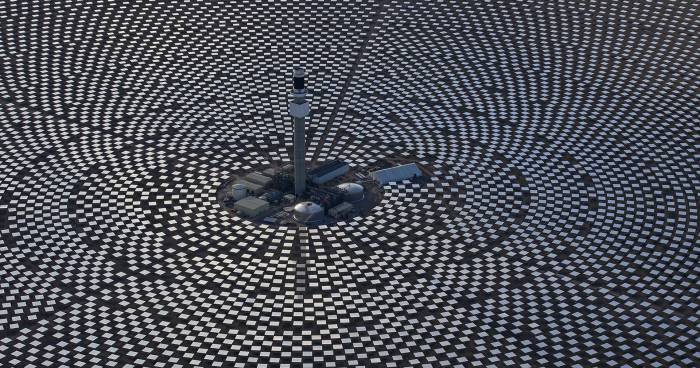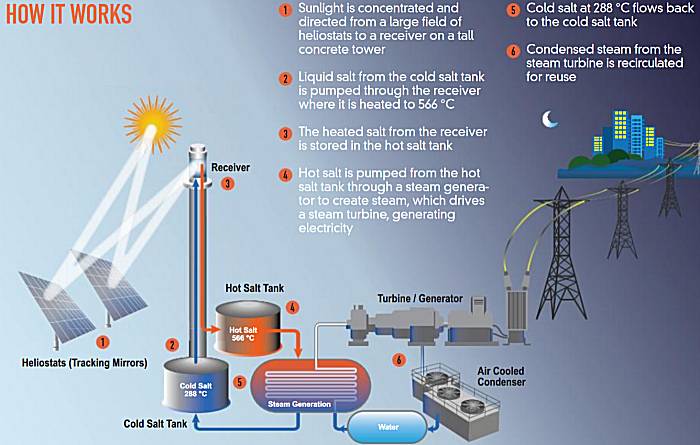
Image: SolarReserve
SolarReserve’s $650 million Aurora solar thermal power station project has been granted development approval by South Australia’s State Government.
The facility, to be constructed 30 kilometers north of Port Augusta, will be the largest of its type in the world and is expected to generate 500 gigawatt-hours of electricity annually.
According to the Australian Energy Market Operator (AEMO), South Australia’s total electricity consumption in 2016-17 was 12,442 gigawatt hours. Based on that figure, this single plant could contribute around 4% of SA’s total electricity requirements.
Instead of conventional solar panels, the Aurora plant will use more than 12,000 automatic, individually controlled dual-axis tracking heliostats (mirrors) to reflect the sun’s energy onto a receiver at the top of a central tower that will be up to 240 metres high. Liquid salt will be pumped through the tower, attaining a temperature of around 560C. The heated salt will be stored and used to create steam to drive a turbine that generates electricity, and the steam then condensed for re-use.

Image: SolarReserve
The plant’s 1,100MWh “molten salt” energy storage system will enable dispatchable power at full load for 8 hours after dark. This is the equivalent of powering more than 230,000 homes (around 30% of all private dwellings in SA) over an eight-hour period says SolarReserve. The company states molten salt can work for 40 years with zero degradation.
In August last year, the South Australian Government awarded SolarReserve a contract for all electricity generated by the facility.
“It’s fantastic that SolarReserve has received development approval to move forward with this world-leading project that will deliver clean, dispatchable renewable energy to supply our electrified rail, hospitals, schools and other major government buildings,” said Acting Energy Minister Chris Picton.
SolarReserve expects to start construction on Aurora this year, assuming final remaining approvals are granted.
The company says 4,000 direct, indirect and induced jobs will be created during construction of Aurora, including 650 full time construction jobs over a period of 2.5 years. Post-construction, there will be 50 full-time permanent jobs in operations and maintenance roles.
Additionally, SolarReserve will be establishing a research partnership with universities in South Australia relating to progressing solar thermal research and education in the state.
“The remarkable story of the transition of Port Augusta from coal to renewable energy – which won a competitive tender against fossil fuel – is also a preview of the future of power generation around the world,” said SolarReserve CEO, Kevin Smith.
The announcement is great news for the community of Port Augusta, which is still suffering the lingering effects of coal power. Earlier this month, Port Augusta Mayor Sam Johnson called for a Royal Commission into the impacts of the operation and closure of Northern Power Station.
Other major solar projects for the region include Port Augusta Renewable Energy Park and Bungala Solar Project.

 RSS - Posts
RSS - Posts



“The plant’s 1,100MW “molten salt” energy storage system will enable dispatchable power at full load for 8 hours after dark.”
1. What is its storage capacity (in MWh or GWh)?
2. How does the capital cost, and the cost per kWh, of this system, compare with an equivalent energy storage capacity battery system with adequate photovoltaic electricity generation to charge such a battery system?
Apologies, I left off the “h” (i.e. should have been MWh) – fixed. Regarding the apples-to-apples comparison cost, I have no idea off the top of my head, but the cost of electricity is to be no more than $78/MWh and expected to be $75/MWh. SolarReserve apparently offered the lowest-cost option of all short-listed bids.
Whilst it does not yet show on this web page (at the time of my writing this post), I am advised that the following was posted;
”
Michael Bloch commented on Port Augusta 150MW Solar Thermal Power Plant Approved.
in response to Michael Bloch:
Apologies, I left off the “h” (i.e. should have been MWh) – fixed. Regarding the apples-to-apples comparison cost, I have no idea off the top of my head, but the cost of electricity is to be no more than $78/MWh and expected to be $75/MWh. SolarReserve apparently offered the lowest-cost option of all short-listed bids.
Looking overseas, just came across this – https://www.documentcloud.org/documents/4340162-Xcel-Solicitation-Report.html#document/p10/a395679
“The median bid price for solar plus battery storage was $36/MWh (3.6 cents/kwh)”
https://thinkprogress.org/colorado-wind-batteries-cheap-12e82b91a543/
… so around AUD $45.75 (size of plants unknown though).
”
which, to me, appears to indicate that “solar plus battery storage” is about 40% less expensive than the “SolarReserve’s $650 million Aurora solar thermal power station project”.
Could this perception please be verified/refuted/clarified?
Thank you in anticipation.
I removed my comment about the comparative costs of storage as when looking into it a bit more, it really wasn’t an apples to apples comparison – too many if, buts or maybes. A comparison can’t be made in that instance.
Some number in this article, the whole project appears wildly uneconomic and of course is only viable using ‘other peoples money’.
http://catallaxyfiles.com/2018/01/15/david-bidstrup-living-in-the-madhouse/
“4,100,000 MWh for $8 million is $1.95 per MWh, slightly less than a capital cost of $32.50 plus $80 for the RET subsidy, (it is “renewable” after all), and probably $20 for operations and maintenance giving $132.50 per MWh, without financing costs. This is 68 times the incremental cost for keeping Port Augusta open and produces 5 years’ worth of “equivalent” power over a 40 year life span.”
Don’t get me wrong, I’d like this to work but it just doesn’t. Seems SA is guaranteed to stay at the top of world electricity prices going forward which crushes business and income.
The solar thermal people suggest this will solve base load power. I don’t think so.
On a sunny day the solar thermal will last 8 hours according to the experts.
1.Unfortunately it is dark for 12 hours…What happens when the heat runs out?
2.What happens in the dead of winter when we get weeks of cloudy sky?
3. All we really need it one cloudy day and the Thermal Power Plant is useless.
Go outside on a cloudy day and you can’t feel the HOT sun!
4.There are no questions on the web about what happens in Winter???
I understand tat our Battery in Jamestown can supply electricity for an hour and that would help but lets see what happens.